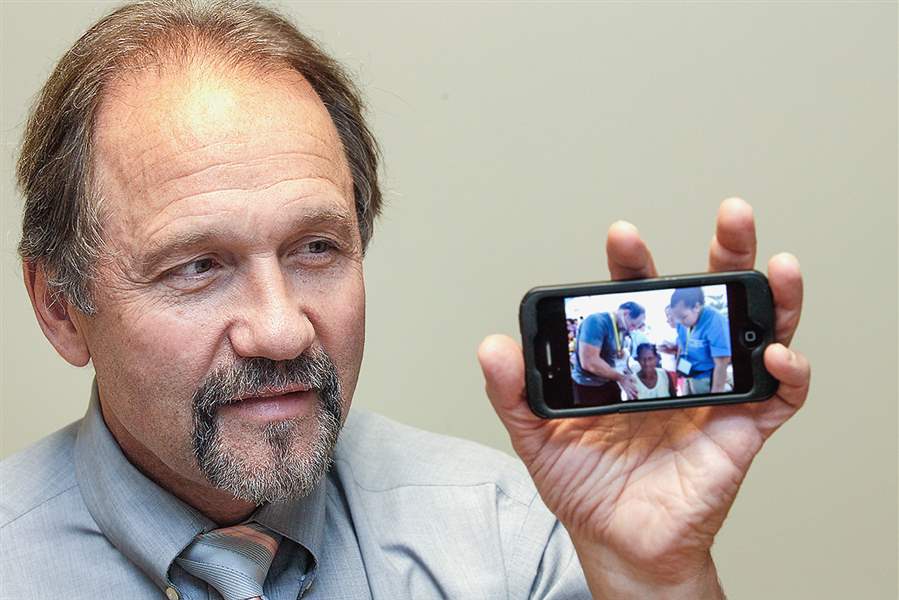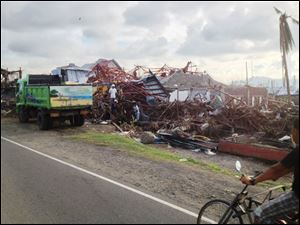
Toledoans aid stricken Philippine city
Medical workers go to Tacloban, heart of disaster
12/23/2013
Above, Dr. Kris Brickman of the University of Toledo Medical Center staff shows one of several cell-phone memories of his recent trip to the Philippines, where he helped with disaster relief after a typhoon wiped out much of the town he visited as part of a relief effort.
The Blade/Lori King
Buy This Image

Above, Dr. Kris Brickman of the University of Toledo Medical Center staff shows one of several cell-phone memories of his recent trip to the Philippines, where he helped with disaster relief after a typhoon wiped out much of the town he visited as part of a relief effort.
Dr. Kris Brickman is an adventure-seeker.
The chairman of the department of emergency medicine at the University of Toledo Medical Center, formerly the Medical College of Ohio, admits he is an adrenaline junkie, so when he was asked to help with relief efforts in the Philippines after a devastating typhoon, he did not hesitate.
He and nine other medical professionals from Toledo returned recently from a mission to assist victims of Typhoon Haiyan, one of the most ferocious ever. It slammed the island nation in early November with 200-mile-per-hour winds, leaving more than 6,000 people dead and nearly 1,800 missing.
“It just hit the heart of the Philippines,” Dr. Brickman said.
As founder and director of the global health program at the former Medical College of Ohio, Dr. Brickman had developed relationships with health officials in the Philippines. He had traveled to the country's capital, Manila, many times on training missions with medical students. This trip was much different.
Dr. Richard Paat, clinical professor of medicine at UTMC, was organizing a medical mission to Tacloban, the hardest-hit city.
Dr. Paat, who is also chairman of medical missions for the Special Commission on Relief Education of the Filipino Association of Toledo, or SCORE, is no stranger to this kind of work. Over the past 19 years, he has organized 54 medical missions to developing countries. Six of them were disaster aid missions.
He took medical professionals to New Orleans after Hurricane Katrina in 2005 and to Haiti after an earthquake destroyed much of the country in 2010, but this trip was more personal for him.
“It's the home country of my parents, and we got a request right away to bring in a medical team,” he said.
“Rich called me over the weekend before the trip and said, 'I'm taking a team on Thursday and I have 10 slots; are you interested in going?’ ” said Dr. Brickman.
The Toledo team stopped in Manila to connect with 20 health professionals from the University of Santos Tomas for the last leg of the 30-hour journey to Tacloban.

At left, Typhoon Haiyan caused widespread devastation in the area Dr. Brickman visited as part of a relief effort.
It was a month after the storm hit, but when they stepped off the plane, “it was quite apparent we were in a different place,” Dr. Brickman said.
The former international airport was in shambles. There were very few planes coming in — mostly helicopters delivering relief supplies.
“What impressed me was just the amount of trash that was just everywhere. The rubble of what used to be their lives was just piled up out there on the streets, on the curbs in big piles that they tried to deal with the best they could, and the best thing they could think of was to just burn it,” said Dr. Brickman.
“It hits homes. Everybody lost everything,” said Dr. Paat.
The group stopped by the abandoned hotel in the center of town that would be their home for the next few days and dropped off their bags. Then it was off to the makeshift clinic to begin seeing patients.
“We hadn't slept in two days when we had to work all day running this clinic, so needless to say we were a bit tired and haggard after day one. And it’s 100 degrees out. I mean we were just sweating like a beast. I mean it was just ugly,” said Dr. Brickman.
The medical students from Manila served as his interpreters and Dr. Brickman estimates he saw 55 to 60 people on the first day with a variety of ailments, from minor injuries to chronic diseases such as diabetes and hypertension.
He said many of the people he treated were suffering from respiratory problems.
“All the smoke and stench and everything in the air — the stuff they were breathing. So these people are inhaling all this smoke and fumes day in and day out and eventually that's gonna cause some irritation to your lungs," he said.
The Toledo group returned home Dec. 10 after two days on the ground traveling from clinic to clinic.
“They will rebuild. The Filipino people are strong. If we were able to help them for a little bit, that was our job,” said Dr. Paat. He estimates the rebuilding process will take at least three years.
Dr. Brickman said he worries about those patients he treated and wonders if they will have another opportunity to see a doctor.
He would like to establish an ongoing relationship with the people in Tacloban so that when the story of the typhoon fades from the headlines, they will not be forgotten.
Dr. Paat said he plans another trip for spring. This trip and others are funded by the SCORE organization.
Donations to the relief effort can be directed to the Web site Scorefat.org.
Contact Marlene Harris-Taylor at: mtaylor@theblade.com or 419-724-6091.